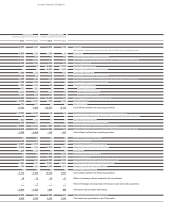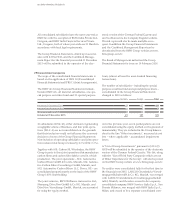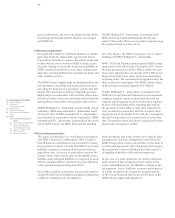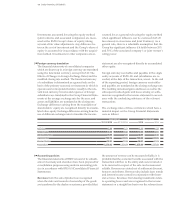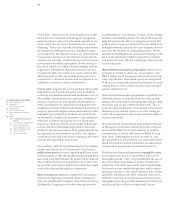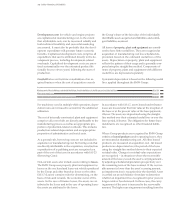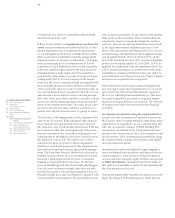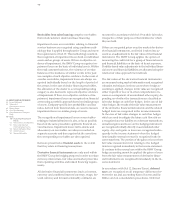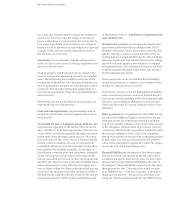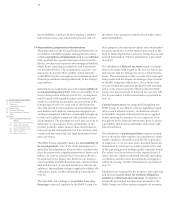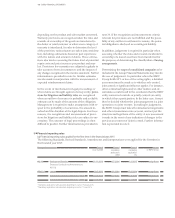BMW 2015 Annual Report Download - page 104
Download and view the complete annual report
Please find page 104 of the 2015 BMW annual report below. You can navigate through the pages in the report by either clicking on the pages listed below, or by using the keyword search tool below to find specific information within the annual report.
104
reversal may not, however, exceed the rolled-forward
amortised cost of the asset.
If there is any evidence of impairment of non-financial
assets (except inventories and deferred taxes), or if an
annual impairment test is required to be carried out –
i. e. for intangible assets not yet available for use, intan-
gible assets with an indefinite useful life and goodwill
acquired as part of a business combination – an impair-
ment test pursuant to IAS 36 (Impairment of Assets)
is performed. Each individual asset is tested separately
unless the cash flows generated by the asset cannot be
distinguished to a large degree from the cash flows
generated by other assets or groups of assets (cash-gen-
erating units / CGUs). For the purposes of the impair-
ment test, the asset’s carrying amount is compared with
its recoverable amount, the latter defined as the higher
of the asset’s fair value less costs to sell and its value in
use. An impairment loss is recognised when the recover-
able amount is lower than the asset’s carrying amount.
Fair value is the price that would be received to sell an
asset in an orderly transaction between market
partici-
pants at the measurement date. The value in use corre-
sponds to the present value of future cash flows ex-
pected to be derived from an asset or group of assets.
The first step of the impairment test is to determine the
value in use of an asset. If the calculated value in use is
lower than the carrying amount of the asset, then its
fair value less costs to sell are also determined. If the lat-
ter is also lower than the carrying amount of the asset,
then an impairment loss is recorded, reducing the car-
rying amount to the higher of the asset’s value in use or
fair value less costs to sell. The value in use is deter-
mined on the basis of a present value computation.
Cash flows used for the purposes of this calculation are
derived from long-term forecasts approved by manage-
ment. The long-term forecasts themselves are based on
detailed forecasts drawn up at an operational level and,
based on a planning period of six years, correspond
roughly to a typical product’s life-cycle. For the pur-
poses of calculating cash flows beyond the planning pe-
riod, the asset’s assumed residual value does not take
growth into account. Forecasting assumptions are con-
tinually brought up to date and regularly compared with
external sources of information. The assumptions used
take account in particular of expectations of the profita-
bility of the product portfolio, future market share de-
velopments, macro-economic developments (such as
currency, interest rate and raw materials prices) as well
as the legal environment and past experience. Cash
flows of the Automotive and Motorcycles CGUs are dis-
counted using a risk-adjusted pre-tax weighted average
cost of capital (WACC) of 12.0 % (2014: 12.0 %). In the
case of the Financial Services CGU, a sector-compatible
pre-tax cost of equity capital of 13.4 % (2014: 13.4 %) is
applied. In conjunction with the impairment tests for
CGUs, sensitivity analyses are performed for the main
assumptions. Analyses performed in the year under
re-
port confirmed, as in the previous year, that no impair-
ment loss was required to be recognised.
If the reason for a previously recognised impairment
loss no longer exists, the impairment loss is reversed
up to the level of the recoverable amount, capped at
the level of rolled-forward amortised cost. This does
not apply to goodwill: previously recognised impair-
ment losses on goodwill are not reversed. No reversals
of impairment losses were recorded in the financial
year 2015.
Investments accounted for using the equity method are
(except when the investment is impaired) measured at
the Group’s share of equity taking account of fair value
adjustments on acquisition. As an exception from this
rule, the associated company, THERE Holding B. V.,
Amsterdam, is included in the Group
Financial State-
ments for the financial year 2015 at its acquisition cost
(at 4 December 2015). Investments accounted for using
the equity method comprise joint ventures and signifi-
cant associated companies.
Investments in non-consolidated Group companies,
non-consolidated joint operations and interests in
asso-
ciated companies, joint ventures and participations
not
accounted for using the equity method, are reported
as Other investments, measured at their fair value. If
this value is not available or cannot be determined relia-
bly, they are measured at cost.
Non-current marketable securities are measured accord-
ing to the category of financial asset to which they are
90 GROUP FINANCIAL STATEMENTS
90 Income Statements
90 Statement of
Comprehensive Income
92 Balance Sheets
94 Cash Flow Statements
96 Group Statement of Changes in
Equity
98 Notes
98 Accounting Principles and
Policies
113 Notes to the Income Statement
121 Notes to the Statement
of Comprehensive Income
122
Notes to the Balance Sheet
147 Other Disclosures
163 Segment Information



